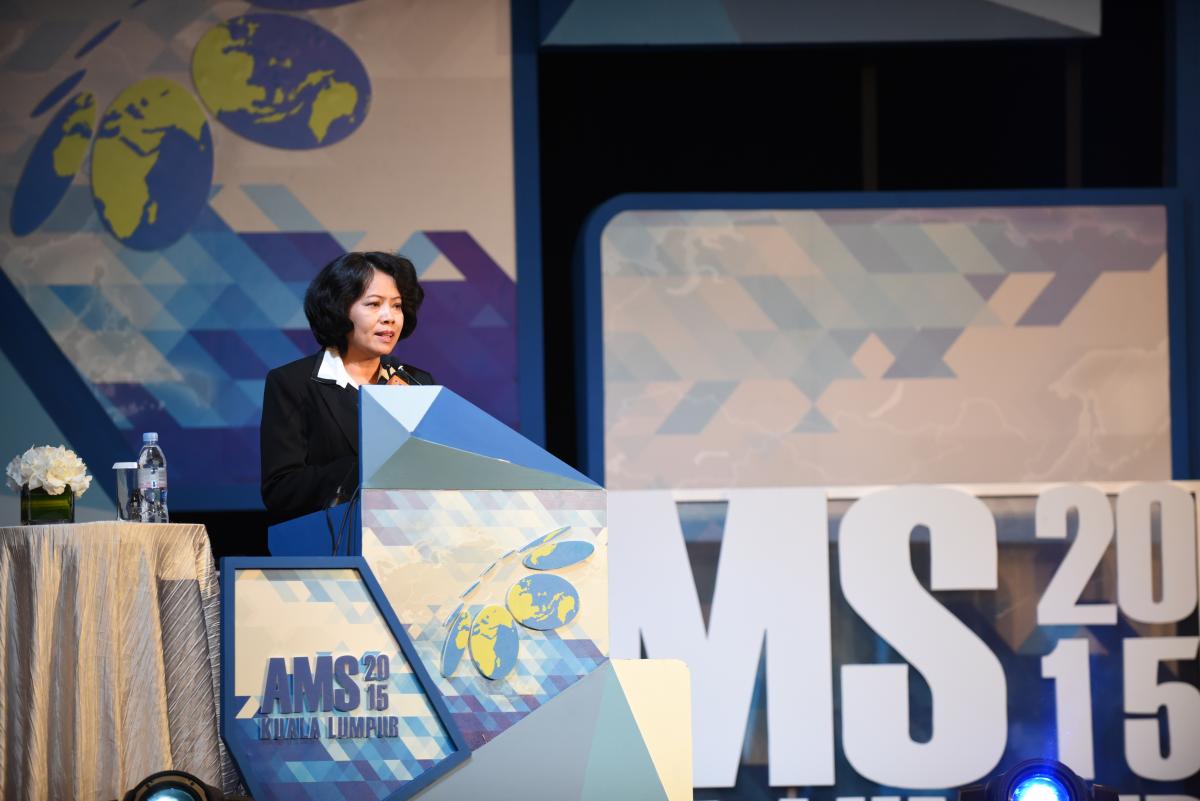Laura-May Coope, Co-founder and Manager of Social Life, BBC, United Kingdom, urged radio broadcasters to derive maximum benefits from social media by inviting their listeners and fans in making them feel special and valued, creating emotional connections, and offering them rewards.
Laura-May Coope, Co-founder and Manager of Social Life, BBC, United Kingdom, urged radio broadcasters to derive maximum benefits from social media by inviting their listeners and fans in making them feel special and valued, creating emotional connections, and offering them rewards.
“Let them play, edit, remix and own parts of what you do using social media”, Ms. Coope told participants who attended the Pre-Summit Workshop on Radio and Social Media on 25 May 2015 in Kuala Lumpur. The one-day seminar was co-organised by AIBD, Radiodays Europe and RCS.
Ms. Coope worked for BBC Radio 1 in rebranding the station for five years, contributing towards making it the biggest radio station on social media in UK.
She cited some examples of programmes that have used social media platforms successfully. Among them were the Eurovision Song Contest which had huge social spaces run by a community of fans, and Radio 1 Breakfast Show that invited dedicated fans to come out with creative ideas who can be part of the program.
“It’s about being creative and not about the ego of traditional broadcasters. We must ensure people are involved in some way in our radio programs,” she pointed out.
In transforming BBC Radio 1, she said that the biggest hindrance was to convince managers and staff to learn more about social media and make it an integral element of the radio shows.
She also said that peoples’ consuming and sharing habits have changed dramatically, and for radio programmes to thrive in the fast changing digital era and growing interconnected world, broadcasters need to experiment and test new concepts.
“Be brave and find the engagement with listeners and fans,” she added.
In his opening remarks, Mr. Chang Jin, AIBD Director, urged radio broadcasters to maximise the opportunities social media offers such as marketing programmes, expanding audience reach, spreading their message, networking and gaining knowledge.
“Radio professionals must find ways to adapt to the challenges of the new landscape created by social media” he said.
Innovative developments in radio in Asia
Another speaker in the workshop was Mr. Steve Ahern, Broadcasting Consultant from Australia, who gave an overview of social media developments in Asia- Pacific.
He cited innovative developments happening with radio in Asia that may impact the future direction of the industry.
One example is BFM Radio in Malaysia, a business station that has successfully pushed their programs into social media platforms.
He said the station mixes music, some funny talents and discussion on financial issues that have increasingly expanded audience reach.
“No traditional broadcaster works with this station, but the network and its talents have come out with innovative and interesting features, landing them as one of the top radio broadcasters in the country”, he said.
Also in Malaysia is im4FM radio station, which is run by young people. Mr. Ahern said the station focuses on youth issues and concerns, doing more than what traditional radio stations do.
Another example is RED FM station in India which has adopted a cheeky and irreverent approach to programmes. He said the station has become popular.
In his presentation, he cited the case of Prime Minister Narendra Modi of India who has rapidly acquired a fan base on the social-media network, becoming the second most-followed world political leader on Twitter after U.S. President Barack Obama.
Known in India as Mr. Social Media, the Indian leader tapped social media to win an election. Every week, the Indian leader gets to interact and chat with his constituents through a radio programme.
Delivering Great Social Media Experiences
Laura-May Coope, Co-founder and Manager of Social Life, BBC, United Kingdom, urged radio broadcasters to derive maximum benefits from social media by inviting their listeners and fans in making them feel special and valued, creating emotional connections, and offering them rewards.
Big Challenges for Broadcasters
Dato’ Sri Ahmad Shabery Cheek, Minister of Communications and Multimedia of Malaysia, raised the possibility that viewers might stop watching TV in the traditional sense unless broadcasters dealt seriously with new trends impacting their industry, among them; the rising popularity of over-the-top or OTT services, the reach and influence of social media, and evolving media consumption behaviour.
Digital Transition in Asia-Pacific
Transition to DTTB services is a complex process yet necessary for broadcasters to remain in business in the longer term. Broadcasters who delay digital switchover transition will lead to increased costs and loss of revenues.
AIBD President Urges Broadcasters to Embrace Social Media
The 12th Asia Media Summit formally opened on 26 May 2015 in Kuala Lumpur, Malaysia, focused on the important role social media plays in transforming broadcasting into a stronger platform fit for now and the future
AMS 2015 : CEO Roundtable
Day 2 - Tuesday, 27th May 2015
1615 - 1730 : CEO Roundtable : Should Broadcasting Compete or Collaborate?
Broadcasting has dominated the communication industry, performing such roles as informing, educating, entertaining, and influencing opinion. Social media and emerging media share these roles. Consequently, they are pulling eyeballs away from television. Is broadcasting in a collision course with social media and to what extent? Should it consider social media competition in content creation, audience engagement and revenue generation? If so, how should broadcasters deal with this new player? Or should it collaborate as both platforms can provide what each other needs and influence people’s lives and routines? How far will collaborative strategies pay off for years to come? Should broadcasting embrace the power of social media to meet its business and civic obligations? Should both compete or collaborate?
AMS 2015 : Parallel Session 4
Day 2 - Tuesday, 27th May 2015
1400 - 1530 : Parallel Session 4 : New Approaches to Deal with Emergency Situations
Social media has become an integral part of disaster education, response and rehabilitation. It can contribute to public awareness as an emergency unfolds, help locate loved ones and notify and alert authorities, and co-ordinate response, recovery and volunteer efforts. It can support rumour management and correction of misinformation. How can broadcasters tap social media tools and manage their risks during emergencies? How do we deal with the risks? What are some best practices in planning for social media use before a disaster occurs, using popular and relevant social media tools, localising disasters in social media use, and in utilising mapping efforts?
AMS 2015 : Parallel Session 3
Day 2 - Tuesday, 27th May 2015
1400 - 1530 : Parallel Session 3 : Creative Content to Enrich Stories & Connect with Audiences
Broadcast organisations now have more access to content. Social media users participate in content creation and influence the type and nature of content. Some content are excellent; others full of abuse and spam. What is critical is to leverage social media to take advantage of compelling content and a rich variety of information sources. How is the creative industry dealing with new sources of content? What social media content is effective to enrich stories, connect with target markets and meet the viewers’ needs? With social media, how can broadcasters enhance various genres of programmes and collaborate in producing high-quality content and enhancing interactivity? What is the best time to post content to social networks?
AMS 2015 : Plenary Session 4
Day 2 - Tuesday, 27th May 2015
1100 - 1230 : Plenary Session 4 : Making Sense of Big Data and Social Data
We encounter so much information that is diverse and growing faster day by day. This big data is migrating to all types of human endeavour, demanding that we see and understand the relations within and among pieces of information and what one can do with it. Big data has become a significant corporate asset and economic input to fuel the information economy. Social media is streaming big data that is appropriate for real time analysis and for communicating information about rapidly changing situations. Social data is mostly non-curated and its reliability varies substantially. What new insights can broadcasters glean from big data and social data? How can broadcasters sift and analyse them to improve content, viewer engagement and operational efficiencies? What analytic tools are useful and effective to drive the value obtained from big data and social data throughout the organisation?
AMS 2015 : Plenary Session 3
Day 2 - Tuesday, 27th May 2015
0900 - 1030 : Plenary Session 3 : Defining and Implementing Legal and Regulatory Guidelines
As social media grows explosively, lawmakers and regulators grapple with important legal and regulatory issues to keep pace with the speed and impact of change. Guidelines to maximise social media’s benefits and protect the public and other stakeholders from its risks are critical. Broadcasters face a similar challenge as they increasingly use social media to inform, educate and influence their audiences and other stakeholders. What regulatory guidelines should be in place to handle the right to privacy, data protection, freedom of information, copyright infringement, and employee rights, among others? Should broadcast organisations do more self-regulation that will need a solid social media policy or should they prepare for more government regulation and stricter enforcement?
AMS 2015 : Moderated Debate
Day 1 - Tuesday, 26th May 2015
1615 - 1730 : Moderated Debate : Journalism, Ethics and Social Media
With the advent of social media, a new breed of journalists is emerging. In blogs and micro blogs, social networking sites and in multimedia content sharing services, these ‘new’ journalists contribute, disseminate and share information. They have also performed news gathering and gatekeeping functions that mainstream media journalists have traditionally carried out. Are mainstream media’s rights, privileges and principles such as truth seeking and independent reporting threatened by the ‘new’ journalists? Are citizen journalists making news more or less accurate? Do we need to reinvent a code of media ethics from the ground up? How do we deal with new values such as transparency over objectivity? How should we treat unfiltered sharing of information over a filtered verification of the facts? What are the best forms of practice, and the norms to guide journalists?









